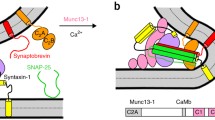Summary
-
1.
Calcium binding properties were examined in VAT-1, an abundant 41-kDa membrane protein expressed in the cholinergic cynaptic vesicles ofTorpedo.
-
2.
An overlay assay, using45Ca2+ as a tracer, demonstrated the ability of a recombinant VAT-1 produced from the IPTG-inducible pKK223-3 expression vector to bind calcium.
-
3.
A high yield of recombinant VAT-1 was obtained from the glutathioneS-transferase (GST) expression system. The fusion product enabled VAT-1 purification via affinity chromatography. Subsequent cleavage by thrombin resulted in its separation from the GST carrier protein.
-
4.
A direct Ca2+-binding study was performed with purified VAT-1 by a quick-spin column technique, in the presence of45Ca2+. Quantitative analysis revealed a 1:1 molar stoichiometry for binding of Ca2+ to VAT-1, with a dissociation constant of 130µM.
-
5.
A GST-linked truncated protein consisting of 13 kDa from the VAT-1 carboxy-terminal domain was found to retain the capacity to bind Ca2+.
-
6.
A data search for homologies between VAT-1 and known Ca2+-binding proetins revealed considerable similarity to members of the annexin family in a 140-amino acid region from the carboxy terminal of VAT-1, which overlaps two tandem Ca2+-binding domains of the annexin proteins.
Similar content being viewed by others

References
Augustine, G. J. (1987). Calcium action in synaptic transmitter release.Ann. Rev. Neursci. 10633–693.
Baimbridge, K. G., Celio, M. R., and Roger, J. H. (1992). Calcium binding proteins in the nervous system.Trends Neurosci. 15303–308.
Blaustein, M. P., and Ector, A. C. (1976). Carrier-mediated sodium-dependent and calcium-dependent calcium efflux from pinched-off presynaptic nerve terminals (synaptosomes) in vitro.Biochim. Biophys. Acta 419295–308.
Brosius, J., and Holy, J. (1984). Regulation of ribosomal RNA promoters with syntheric lac operator.Proc. Natl. Acad. Sci. USA 813696–3701.
Cowan, D. M., Linial, M., and Scheller, R. H. (1990).Torpedo synaptophysin: Evolution of a synaptic vesicle protein.Mol. Brain Res. 5091–7.
Geisow, M. J., Walker, J. H., Boustead, C., and Taylor, W. (1987). Annexin—new family of Ca2+ regulated phospholipid-binding proteins.Biosci. Rep. 7289–298.
Guan, K. L., and Dixon, J. E. (1991). Eukaryotic proteins expressed in Escherichia coli: An improved Thrombin cleavage and purification of fusion proteins with glutathione-S transferase.Anal. Biochem. 192262–267.
Laemmli, U. K. (1970). Cleavage of structural proteins during the assembly of the head of bacteriophage T4.Nature 227680–685.
Linial, M., Miller, K., and Scheller, R. H. (1989). VAT-1: An abundant membrane protein from Torpedo cholinergic synaptic vesicles.Neuron 21265–1273.
Llinas, R., Sugimori, M., and Silver, R. B. (1992). Microdomains of high calcium concentration in the presynaptic terminal.Science 256677–679.
Malenka, R. C., Kauer, J. A., Perkel, D. J., Mauk, M. D., Kelley, P. T., Nicoll, R. A., and Waxham, M. N. (1989). An essential role for postsynaptic calmodulin and protein kinase activity in long term potentiation.Nature (Lond.)335820–824.
Maruyama, K., Mikawa, T., and Ebashi, S. (1984). Detection of calcium binding proteins by45Ca2+ autoradiography on nitrocellulose membrane after SDS gel electrophoresis.J. Biochem. (Tokyo)95511–519.
Moriyama, Y., and Nelson, N. (1989). Lysosomal H+-translocating ATPase has a similar subunit structure to chromaffin granule H+-ATPase complex.Biochim. Biophys. Acta 980240–247.
Nachshen, D. A. (1985). Regulation of cytosolic calcium concentrations in presynaptic nerve endings isolated from rat brain.J. Physiol. (Lond.)36387–101.
Sudhof, T. C., and Jahn, R. (1991). Proteins of synaptic vesicles involved in exocytosis and membrane recycling.Neuron 6665–677.
Tsien, R., and Zucker, R. S. (1986). Control of cytoplasmatic calcium with photolabile 2-nitrobenzhydrol tetracarboxylate chelators.Biophys. J. 50843–853.
Trimble, W. S., Linial, M., and Scheller, R. H. (1991). Cellular and molecular biology of the presynaptic nerve terminal.Annu. Rev. Neurosci. 1493–122.
Volknandt, W., Schlafer, M., Bonzelius, F., and Zummermann, H. (1990). Svp25, a synaptic vesicle membrane glycoprotein from Torpedo electric organ that binds calcium and forms a homooligomeric complex.EMBO J. 92465–2470.
Yamada, W. M., and Zucker, R. S. (1992). Time course of transmitter release calculated from simulations of a calcium diffusion model.Biophys. J. 61671–682.
Author information
Authors and Affiliations
Rights and permissions
About this article
Cite this article
Levius, O., Linial, M. VAT-1 fromTorpedo synaptic vesicles is a calcium binding protein: a study in bacterial expression systems. Cell Mol Neurobiol 13, 483–492 (1993). https://doi.org/10.1007/BF00711457
Received:
Accepted:
Issue Date:
DOI: https://doi.org/10.1007/BF00711457



